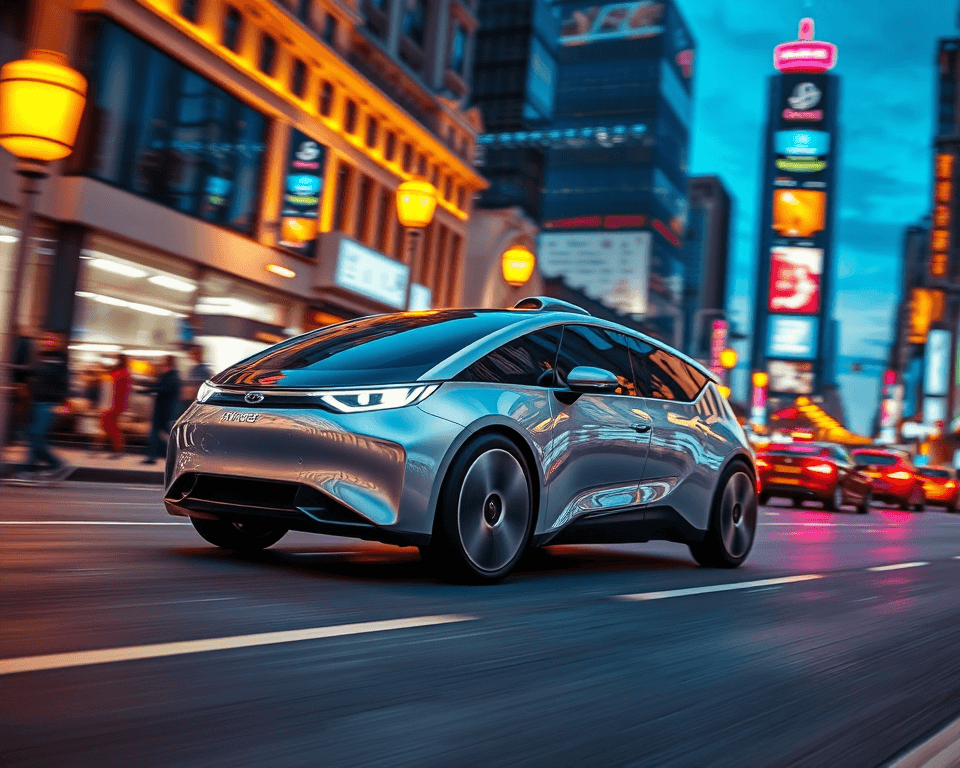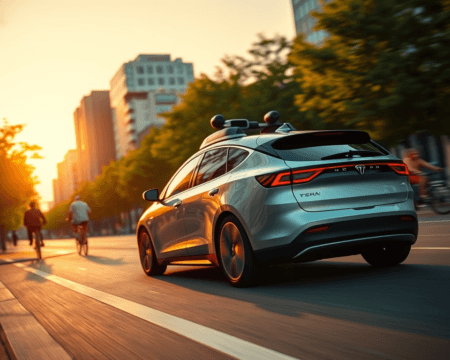Man, if you’re even a wee bit interested in self-driving cars, you’re in for a treat. Imagine zipping around without needing to navigate that craziness we call traffic. I mean, who wouldn’t want to kick back and enjoy the ride? Today, we’re gonna chat about some seriously cool technologies that are revving up the realm of autonomous vehicles. If you’re thinking, “How can self-driving cars get better?” then stick with me as we break down some cutting-edge stuff that’ll make these machines smarter, safer, and just overall way cooler.
Key Takeaways
- Advanced sensor technologies and enhanced AI capabilities are leading the charge in making self-driving cars safer and more efficient.
- Improved communication networks like V2X will significantly increase vehicle connectivity, reducing reaction times on the road.
- Safety features are continuously evolving, with predictions about integrated safety systems and regulatory advancements coming into play.
1. Advanced Sensor Technology
I gotta tell you, when it comes to self-driving cars, sensors are like their eyes and ears. Without them, autonomous vehicles are basically flying blind. Right now, the tech scene is buzzing about lidar, radar, and precision cameras that can perceive their environment in 3D. And believe it or not, but we’re not just talking fuzzy images; we’re looking at ultra-sharp data that can track objects with insane accuracy.
1.1 Overview of Current Sensor Technologies
Picture this: the latest Tesla Model S, boasting state-of-the-art sensor fusion capabilities that combine radar and cameras to detect obstacles in real-time. This car has a knack for recognizing pedestrians and cyclists before you even see them. That’s thanks to its perception systems that effectively process data to keep drivers safe—an absolute win-win!
But there’s a catch: all these components need to integrate seamlessly. If one sensor goes haywire, it could throw the whole operation off. And right now, that’s a real concern. The reliability of these sensors is crucial in ensuring that cars don’t mistake a shadow for a potential hazard.
1.2 Enhancements in Sensor Performance
What’s cool about the sensor game is it’s always evolving. Companies are investing heavily in cutting-edge sensors that boast improved dynamic range and even handle different weather conditions—a lifesaver during those stormy nights. For instance, the Waymo One has improved its lidar sensors to detect objects further away with higher accuracy, enabling the vehicle to make better decisions sooner.
Here’s the kicker: advancements aren’t always about throwing more money into the mix. Some companies are finding cost-efficient ways to enhance sensor performance, making it easier for manufacturers to adopt these technologies. This isn’t just about luxury cars; it’s about making self-driving tech accessible to the everyday person!
2. Artificial Intelligence and Machine Learning
Now, let’s talk about the brain behind the brawn: artificial intelligence. Seriously, if sensors are the eyes, AI is the mind of these cars. It processes the data collected by the sensors and makes real-time decisions that could save lives. You definitely want a smart car—not just any ol’ hunk of junk.
2.1 Machine Learning Applications in Autonomous Vehicles
Did you know AI algorithms are getting more advanced every day? It’s all about pattern recognition and behavioral prediction. Think about how Uber’s self-driving technology learns from every trip it makes. With every mile logged, it analyzes endless data to enhance the decision-making process—let’s just say it learns how to act like an experienced driver.
The real magic happens when AI systems utilize training data to calibrate their models. So the more a car drives, the smarter it gets. And yes, this is precisely why companies are pushing for broader acceptance of autonomous vehicles: they’re essentially self-improving. Imagine your car being able to adapt to your driving style—pretty wild, right?
2.2 Future Trends in AI for Self-Driving Cars
AI isn’t just stopping at what it can do today; it’s always looking ahead. Innovations like predictive modeling and real-time AI are set to ramp up capabilities significantly. For instance, self-driving cars will soon communicate with each other and the infrastructure around them, predicting potential hazards ahead.
Moreover, there’s a growing conversation about the ethical implications of AI, particularly how to regulate and control these intelligent systems while ensuring public safety. Questions on data ownership and liability come into play, making it a hot topic not just for developers but for policymakers.
3. Improved Communication Networks
Ever hear of V2X (vehicle-to-everything) technology? It might sound sci-fi, but it’s already changing the game for self-driving cars. Think about how having fast and reliable communication networks can improve the experience and safety of autonomous vehicles. With 5G around the corner, low-latency communication is about to become the new standard.
3.1 The Role of V2X Communication
Right now, a significant percentage of accidents come from human error. But imagine a world where cars can “talk” to each other. With V2X communication, vehicles exchange information with their surroundings, such as road conditions or impending traffic jams—making real-time decisions that could prevent accidents and improve overall traffic management.
Take the Nissan Intelligent Mobility initiative, for example. Their vehicles are already capable of communicating with traffic signals, allowing them to adjust speed before approaching a red light. It’s all about forming collaborative systems to enhance safety and streamline how we move.
3.2 Future Innovations in Communication for Self-Driving Cars
And trust me, the innovative streak isn’t stopping there. Edge computing and digital twin technology are on the horizon. These advancements will enable better decision-making right where the data is created rather than relying solely on a centralized system. Plus, we could one day see quantum communication streamlining data transfer like never before—have you ever pictured a smart city where everything is connected? Well, that future is closer than you might think!
| Technology | Benefits | Current Adoption |
|---|---|---|
| 5G Connectivity | Low latency, real-time updates | Growing in urban areas |
| V2X Communication | Enhanced traffic management | Piloted in selected cities |
| Edge Computing | Faster processing, reduced lag | Emerging in smart cities |
4. Enhanced Safety Features
Okay, let’s get real here. Safety is the name of the game when it comes to self-driving cars. Not only should they be fun and efficient, but they also need to ensure passengers are safe—period. We’re seeing some amazing innovations in this space.
4.1 Current Safety Technologies and Features
Today’s autonomous vehicles come loaded with advanced driver assistance systems (ADAS) that help mitigate risks. For example, the Volvo XC90 has automated braking and pedestrian detection features which have been proven to reduce accidents significantly. If that doesn’t scream safety, I don’t know what does!
These technologies continuously undergo performance testing, validation, and user feedback collection to ensure they perform as required. Car manufacturers publish ranks and ratings based on tests, giving consumers peace of mind while making purchasing decisions.
4.2 Future Directions in Safety Technologies
But hold your horses, folks! The future is here, and it’s all about integrated safety systems that go beyond individual features. Imagine predictive safety measures that actively adjust to your driving environment by analyzing data in real-time. We’re talking about cars that will not only react but also anticipate changes around them.
And as we roll down this road, legislation will catch up. So, keep an eye out for safety certifications that ensure new tech meets stratospheric safety standards. With public acceptance as a key hurdle, we’ll need to show that these advanced systems work and can be trusted to protect lives.
5. Regulatory Developments and Ethical Considerations
Let’s not kid ourselves—regulations are a huge part of this entire convo. While technology is racing ahead, the legal landscape sometimes lags behind like a slowpoke on the highway.
5.1 Current Regulations Affecting Self-Driving Cars
Right now, we’ve got a patchwork of regulations affecting self-driving cars, depending on where you live. The NHTSA has existing regulations that outline standards for safety, but as technology evolves, the legal landscape has to keep up. Policymakers are constantly scrambling to understand what’s safe and what isn’t.
Manufacturers like Ford are working tirelessly to meet these compliance measures to avoid getting stuck in legal red tape. It’s a tough nut to crack, but one that can’t be ignored.
5.2 Future Regulatory Trends and Ethical Considerations
As we’ve seen, ethical dilemmas are big players in this drama. Data ownership and liability—who’s responsible if a self-driving car makes a mistake? Manufacturers? Users? Regulators? These are questions we must tackle as new systems evolve. Future legislation will need to adapt swiftly to protect the public while fostering innovation.
Engaging stakeholders at every stage, from manufacturers to drivers, and balancing public trust with regulations will set the tone for future developments in self-driving technology.
“A world with autonomous vehicles can only thrive if the public feels safe and informed by the regulatory frameworks that govern it.”
Here’s the bottom line: understanding these technologies and how they’ll impact our everyday lives can steer us toward a future where self-driving cars enhance our commuting experience instead of scaring us away from them. Keep your eyes peeled—this is the future rolling right up to you!
Frequently Asked Questions
How do self-driving cars detect obstacles?
Self-driving cars utilize advanced sensor technologies such as lidar, radar, and cameras to effectively detect obstacles. These sensors work in conjunction through sensor fusion, enabling the vehicles to create detailed 3D maps and accurately perceive their environment in real-time.
What role does artificial intelligence play in autonomous vehicles?
Artificial intelligence (AI) is essential for enabling self-driving cars to make decisions based on sensor data. AI algorithms analyze patterns, predict driver behavior, and adapt to changing conditions to facilitate safe and efficient driving without human intervention.
What benefits does V2X communication offer for self-driving cars?
Vehicle-to-everything (V2X) communication enhances safety and efficiency by allowing vehicles to communicate with each other and infrastructure. This real-time data exchange improves traffic management, reduces accidents, and helps optimize traffic flow, making roads safer for everyone.
How can self-driving cars adapt to adverse weather conditions?
Advanced sensor technology has improved in dynamic range and accuracy, enabling self-driving cars to perform reliably in adverse weather situations, such as rain or fog. These enhancements allow vehicles to maintain safety and accuracy in their perception systems despite challenging environmental conditions.
What are the current safety features in self-driving cars?
Current safety features in self-driving cars include automated braking, collision avoidance systems, and various advanced driver assistance technologies. These features work together to enhance vehicle safety, reduce the likelihood of accidents, and comply with established safety regulations.
Are there specific regulations governing self-driving cars?
Yes, there are numerous regulations concerning self-driving cars that vary by region. Regulatory bodies are responsible for establishing safety standards, compliance measures, and the approval processes necessary for autonomous vehicle operation.
What ethical considerations surround the use of self-driving cars?
Ethical considerations for self-driving cars encompass data privacy, liability in accidents, and decision-making processes in emergency situations. Ongoing discussions aim to create ethical frameworks that balance innovation with public trust and safety.
How will future technologies impact the development of self-driving cars?
Future technologies, such as quantum communication, edge computing, and enhanced AI models, are expected to significantly improve the performance and reliability of self-driving cars. These advancements will enable better decision-making, more effective communication, and improved safety protocols.
What should consumers consider before embracing self-driving technology?
Consumers should consider the current capabilities and limitations of self-driving technology, including safety features, regulatory developments, and ethical implications. Understanding these factors can help consumers make informed decisions regarding the adoption of autonomous vehicles.










